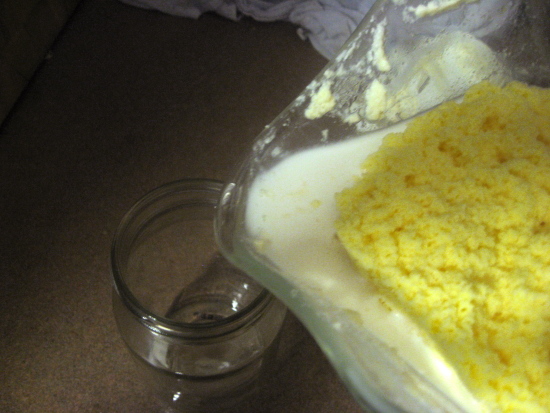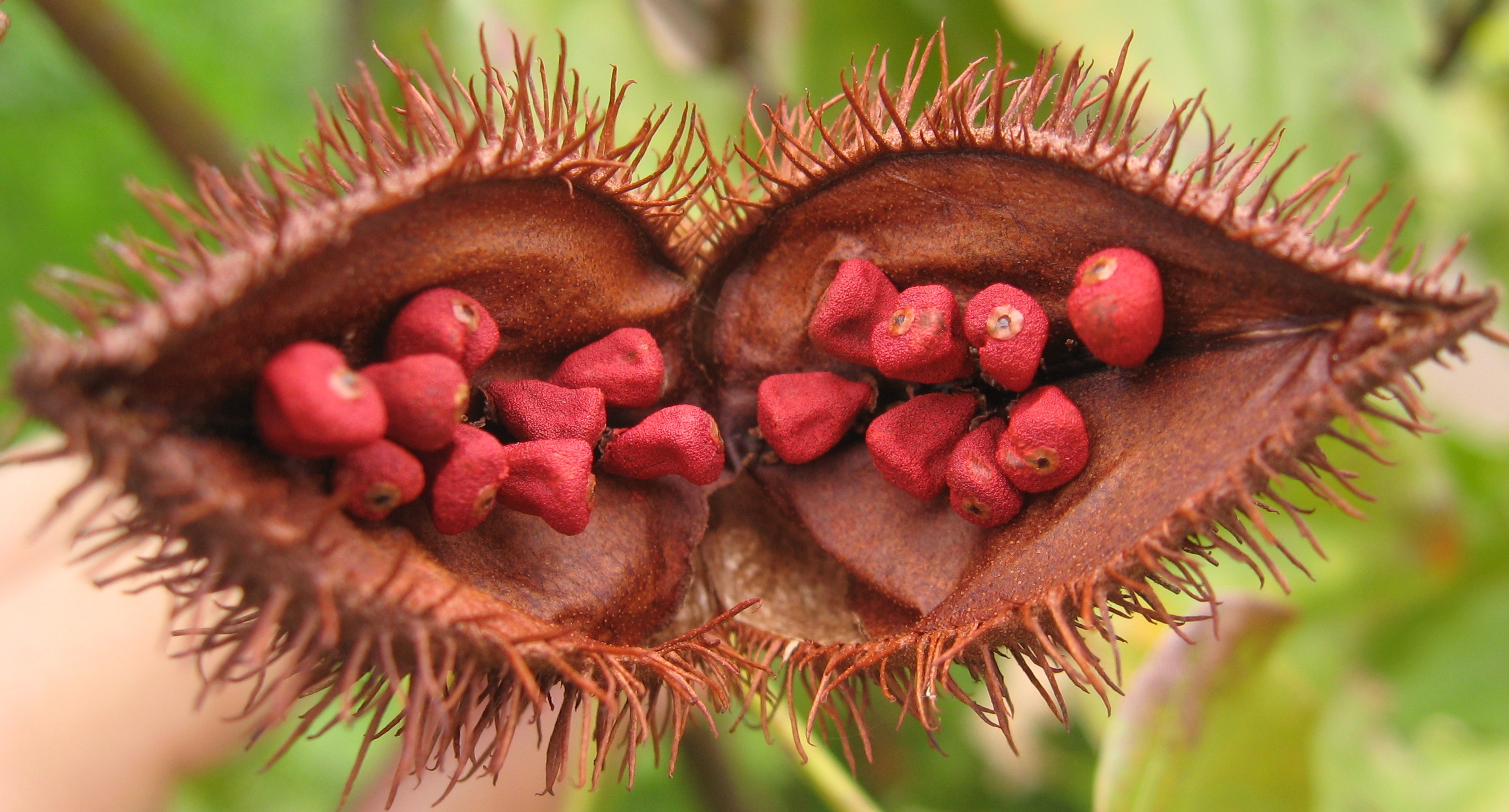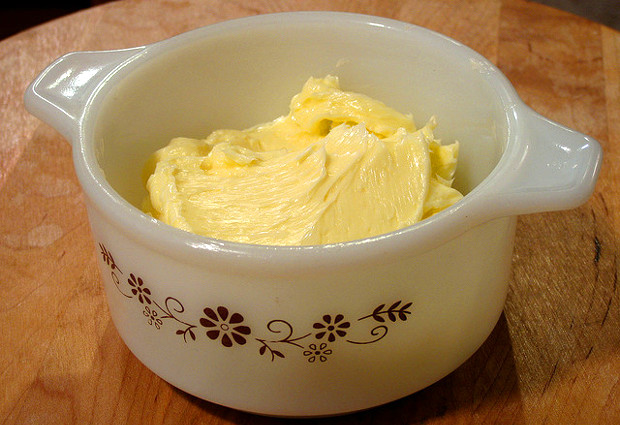I've been reading about butter lately. Not margarine, actual butter. Here are some things I have learned:

Butter. Smooth, creamy, a hint of salt. But what color should it be? Yellow? Cream? Ivory?
(Photo from 5 Degrees of Inspiration)

Milk that's been churned (or that's gone through about 5 minutes in the food processor) and that has separated into buttermilk and fat solids, which are yellow. The fat solids are what becomes butter.
(Photo and instructions for how to make your own butter with a food processor from Food Renegade)
(By the way, this is what annatto is. Sorry for the scary-looking picture, but that's how it grows.)

Seed pods of the achiote tree, which grows in South America
(Photo from Wikipedia)

The seeds are harvested and ground up, and the powder is then used to make an oil that will turn food yellow or orange very easily.
(Image from Karma-Free Cooking)

Or should butter be more yellow, like this?
(Photo from The Gluten Doctors)

Ad for a WWII-era margarine's "Color-Kwik bag" of yellow pigment
(Image from The Society Pages)

Here's another margarine ad, this one with the E-Z Color Pak. When they spell it funny, you know it's kwality.
(Image from Ancestors in Aprons)

Food Renegade's homemade butter -- made from raw cream that came from grass-fed cows. The yellow is from the grass, not from adding added coloring. But if she made another batch of butter using a different type of cream, probably the color would have turned out slightly different.
(Photo from Food Renegade)

Here's the best part about butter, how it melts on things like this muffin, and makes things all warm and melty and creamy and mmmm.
(Photo from Wikimedia)
Sources
Doug & Linda's Dairy Antique Site, Other Dairy Antiques
Wikipedia (German) Butter
Dairy Farmers of Canada, Butter Facts & Fallacies The Society Pages, The Politics of Yellow: Butter vs. Margarine
Butter. Smooth, creamy, a hint of salt. But what color should it be? Yellow? Cream? Ivory?
(Photo from 5 Degrees of Inspiration)
- Butter is yellow because of the grass that cows eat.
- Grass contains carotenoids--pigments that are present in plants--which are yellow. (You might remember I mentioned these in the entry about how leaves change color.)
- Here's the process:
- The cow eats grass, and so therefore also eats carotenoids.
- When the cow is milked, the carotenoids from the grass go right along into the milk.
- When the milk gets churned, it separates into fat solids and buttermilk. Since the yellow-pigment carotenoids are fat-soluble (which means they cling to fat), more of those go with the fat solids than the buttermilk.
- The buttermilk is strained off.
- The fat solids that are rich with the yellow pigment get shaped into butter. Which is yellow.
Milk that's been churned (or that's gone through about 5 minutes in the food processor) and that has separated into buttermilk and fat solids, which are yellow. The fat solids are what becomes butter.
(Photo and instructions for how to make your own butter with a food processor from Food Renegade)
- True, make-it-yourself butter will vary in shades of yellow from one batch to the next. The amount of yellow depends on all sorts of factors such as
- What type of grass/silage/hay/cereal the cows have eaten, or what time of year it is when they're milked. If the cows have eaten dried grasses during the winter, their milk will be paler in color.
- The breed of cow -- how much of the pigment passes into the milk varies by type of cow (Guernsey cows produce a golden yellow milk fat, while Holstein cows produce white cream)
- Even within a single breed, from which cows the milk has been collected.
- Many commercially produced butters have additional yellow coloring from annatto (a seed with lots of carotenoids) or carotene (often derived from marigolds, essentially carotenoids) to make the color of the butter uniform, and also to give butter the yellow color that people expect it to have.
(By the way, this is what annatto is. Sorry for the scary-looking picture, but that's how it grows.)

Seed pods of the achiote tree, which grows in South America
(Photo from Wikipedia)

The seeds are harvested and ground up, and the powder is then used to make an oil that will turn food yellow or orange very easily.
(Image from Karma-Free Cooking)
- Back in the way-back day, before government regulations outlawed such things (hey! regulations can be helpful!) people used to sell "adulterated butter" -- butter which was made with less butterfat and substituting vegetable oils or tallow or some other kind of cheaper fat, but they'd sell it for the same price as regular butter. Or they'd take butter that had turned rancid, boil it, add some fresh milk to it, churn it, and sell it like it was fresh.
- Since people assumed that butter that is less yellow has less fat (not necessarily true, but it's an assumption people made), the bad-butter-sellers would disguise their bad butter by adding yellow coloring. But the things they used to dye the butter yellow were pretty horrible, such as coal tar or coal tar-derivatives, or copper, which is poisonous.

Or should butter be more yellow, like this?
(Photo from The Gluten Doctors)
- (By the way, adulterated butter is still sometimes an issue. Not butter with coal tar or copper, but butter that doesn't have the required amount of butterfat. Regulators occasionally still have to crack down on bad-butter-sellers every once in a while, for substituting cheaper vegetable oils for butter fat and selling it at a high-quality-butter price. Acceptable butter should be about 80% butter and 15% water.)
- When margarine was widely produced during World War II due to rationing, people were suspicious of it because it didn't look yellow like butter. So margarine manufacturers started including packets of yellow powder that you would mix with the margarine to make it yellow like butter. But it was a saturated, super-yellow color.

Ad for a WWII-era margarine's "Color-Kwik bag" of yellow pigment
(Image from The Society Pages)

Here's another margarine ad, this one with the E-Z Color Pak. When they spell it funny, you know it's kwality.
(Image from Ancestors in Aprons)
- But people got used to that. So when margarine eventually became more popular than butter, then people thought the super-saturated yellow of margarine was what butter ought to look like. So when people went back to buying butter, which had a paler yellow or almost creamy color, they thought, hey, there's something wrong with this butter, it's not yellow like it should be.
- So now butter manufacturers have started to add more dye to color the butter to make it look like margarine. Today, though, they use annatto or carotene -- neither of which is toxic.

Food Renegade's homemade butter -- made from raw cream that came from grass-fed cows. The yellow is from the grass, not from adding added coloring. But if she made another batch of butter using a different type of cream, probably the color would have turned out slightly different.
(Photo from Food Renegade)

Here's the best part about butter, how it melts on things like this muffin, and makes things all warm and melty and creamy and mmmm.
(Photo from Wikimedia)
Sources
Doug & Linda's Dairy Antique Site, Other Dairy Antiques
Kendra Smith-Howard, Pure and Modern Milk: An Environmental History Since 1900, page 60ff.
The Nineteenth Century and After, vol 62, 1907, page 413
Anthony S. Wohl, Adulteration and Contamination of Food in Victorian England
No comments:
Post a Comment
If you're a spammer, there's no point posting a comment. It will automatically get filtered out or deleted. Comments from real people, however, are always very welcome!